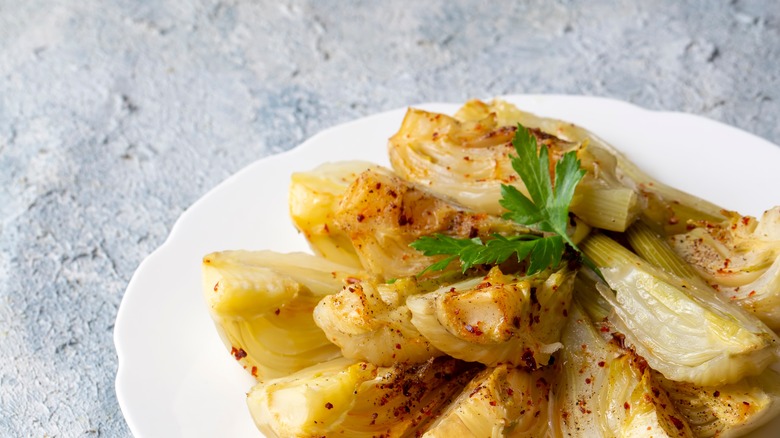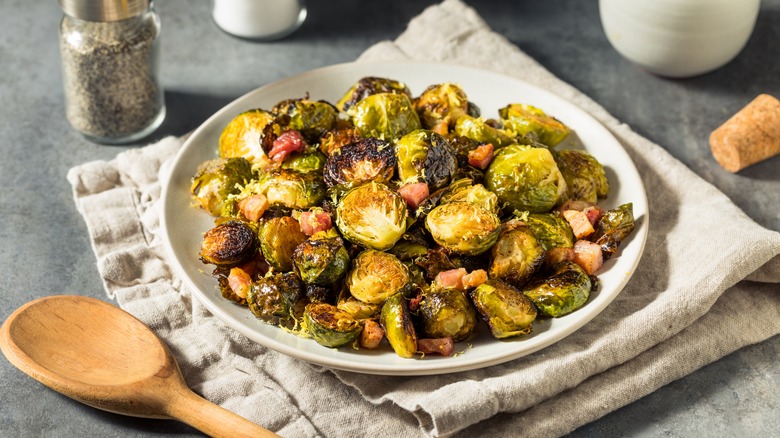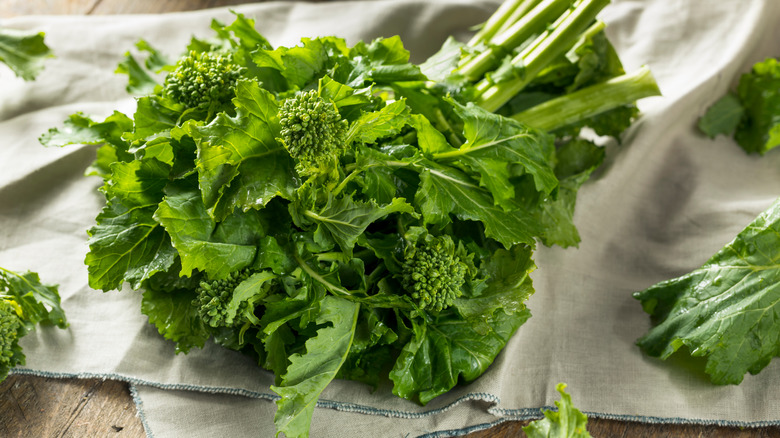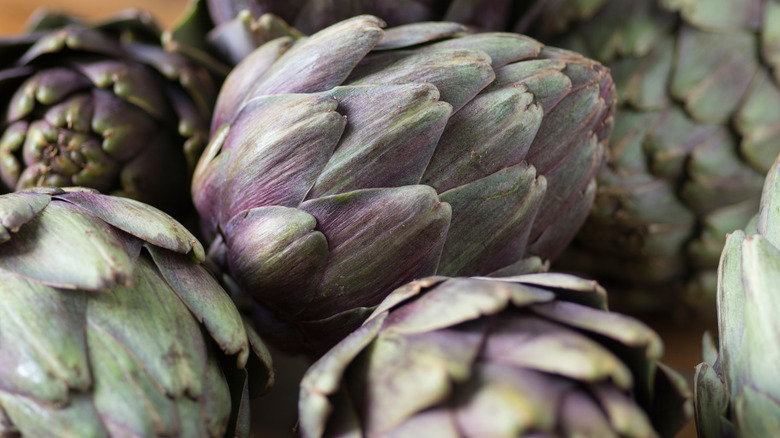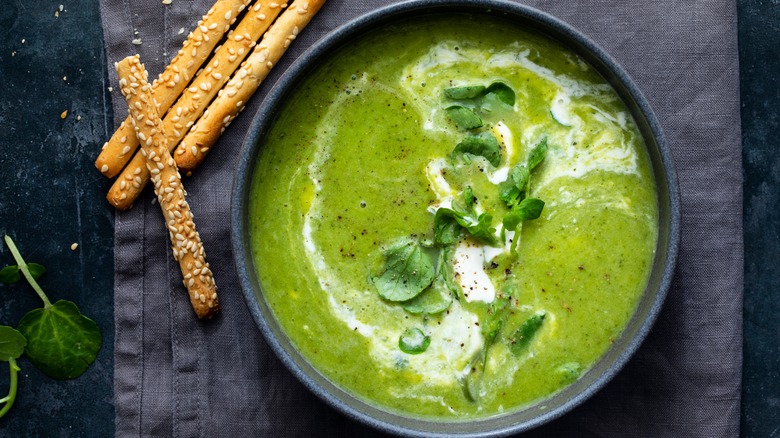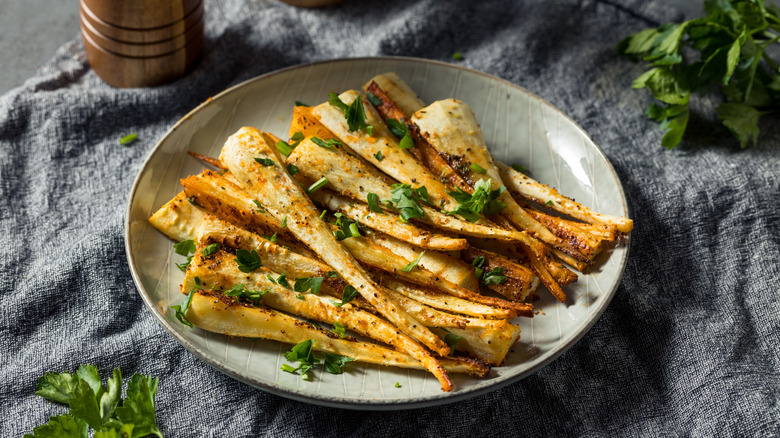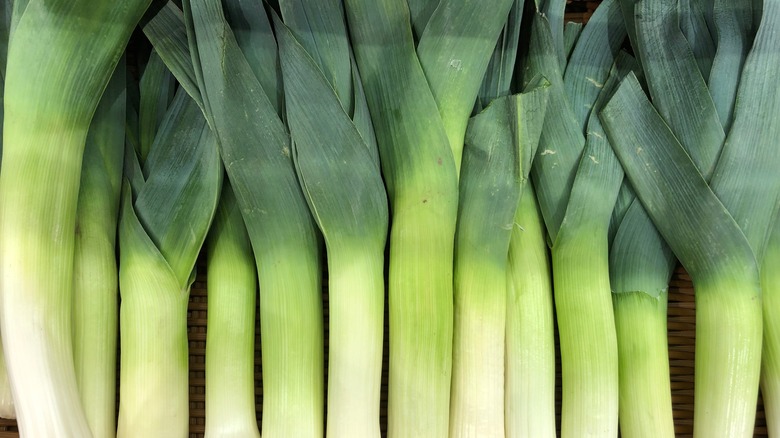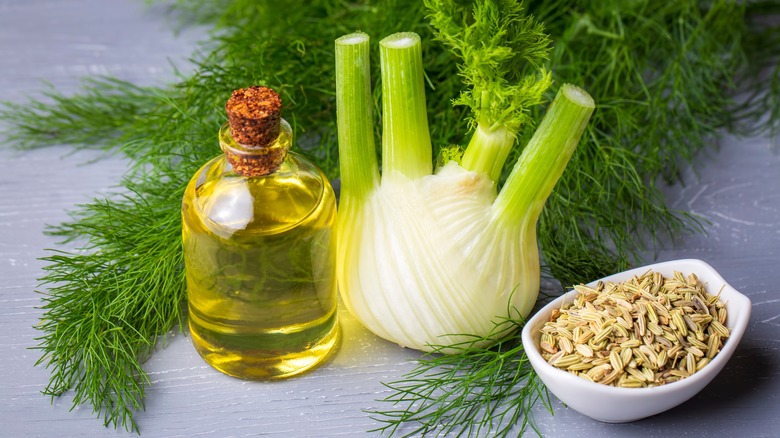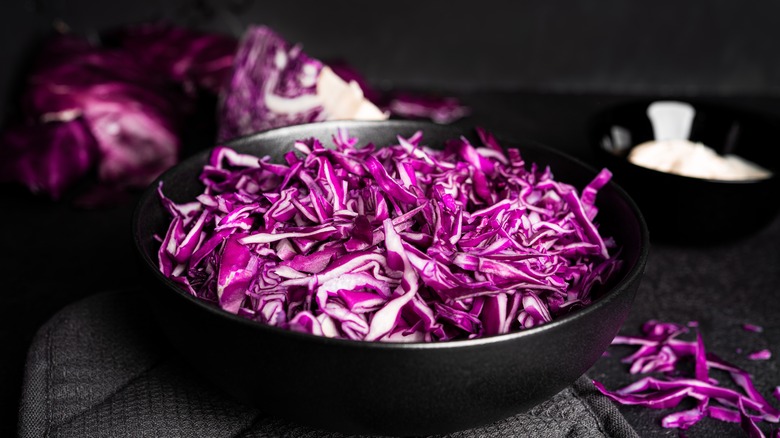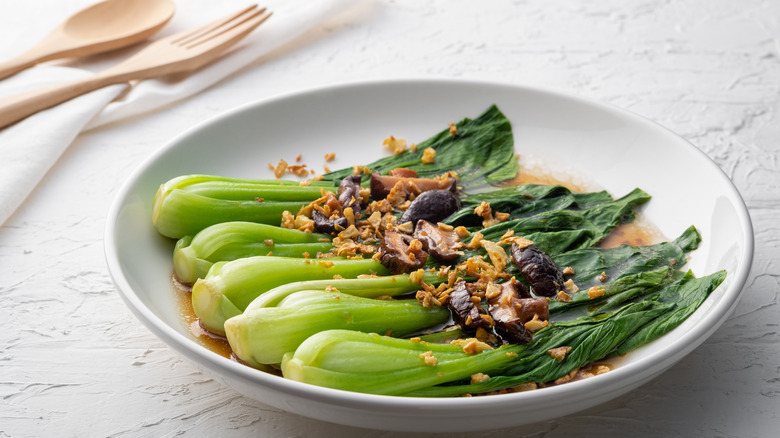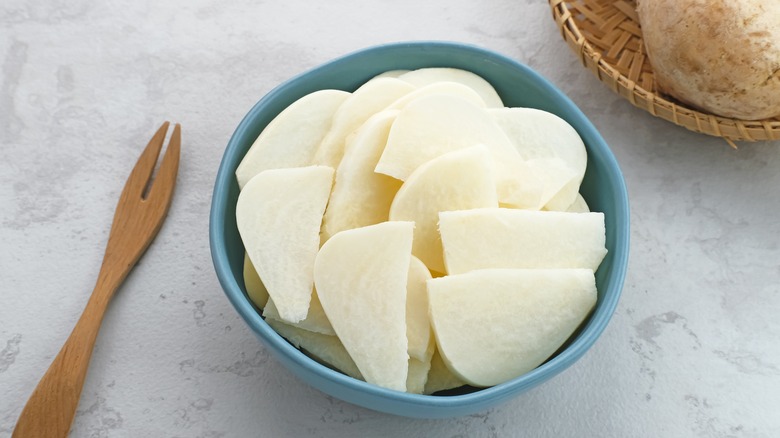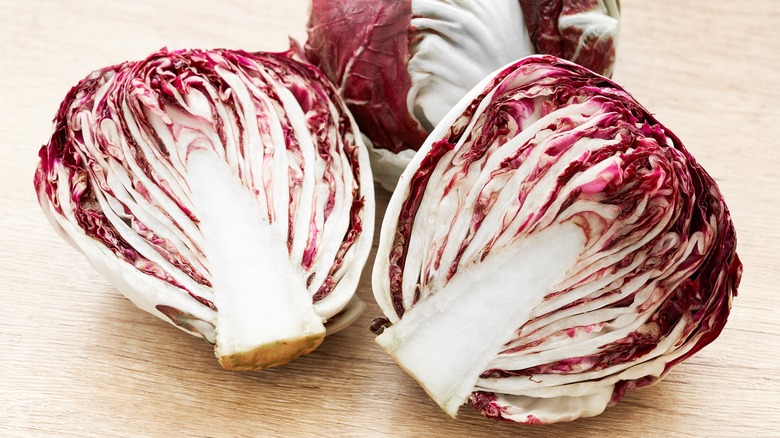11 Underrated Vegetables You Should Stop Overlooking
Are you eating enough vegetables? If you're like most Americans, probably not. According to the Centers for Disease Control and Prevention (CDC), only 10 percent of adults are noshing the recommended 2 to 3 cups of veggies per day. Vegetables contain important vitamins, minerals, dietary fiber, and antioxidant nutrients that have myriad benefits for your health. Eating plenty of veggies — and fruit — has been shown to help reduce your risk of chronic disease, including diabetes and heart disease, and aid weight loss and maintenance.
If your go-to veg rotation is broccoli, spinach, and carrots, it's time to change things up. A little more variety and a few new recipes in your box of kitchen tricks can help you eat more veggies and enjoy them more. Next time you're perusing the produce aisle or local farmers market, pick up one of these lesser-loved but oh-so-delicious vegetables and give them a try.
1. Brussels sprouts
This may be an unpopular opinion, but Brussels sprouts are delicious — if you know how to prepare them. Brussels sprouts belong to the cruciferous family of vegetables. This group also includes other tasty options like arugula, cabbage, broccoli, and kale (via the National Institutes of Health).
Cruciferous veggies are nutrient powerhouses. They're abundant in vitamins C, E, K, and the nutrient folate, and minerals. They also offer a bounty of dietary fiber, which protects heart health, improves digestion, and aids blood sugar control and weight loss and maintenance (via the Mayo Clinic). They are also a rich source of antioxidants called carotenoids, including beta-carotene, lutein, and zeaxanthin. These substances have wide-ranging benefits for human health, including boosting the immune system and heart health, as well as protecting your eyesight (via Healthline).
If you hate Brussels sprouts because you've only had them when they're an overcooked mushy mess, we get it. But there is so much more to these little bundles of nutrients. Pan-fried Brussels sprouts are crispy, flavorful, and easy to prepare with just a few ingredients. Roasting is another delicious way to prepare Brussels sprouts. These balsamic-roasted sprouts are crispy, sweet, sour, and — don't say we didn't warn you — addictive!
2. Broccoli rabe
Another member of the cruciferous vegetable family, broccoli rabe is a leafy green that is not actually part of the broccoli family (via WebMD). Sometimes referred to as rapini, raab, spring raab, brocoletti, or Ruvo raab, its flavor is quite close to broccoli. However, it shares the nutritional benefits of broccoli and other members of the cruciferous family of veggies. This includes high amounts of vitamins C, E, K, and folate. Broccoli raab is a particularly rich source of vitamin K, with one serving providing 181 percent of the daily value (via MyFoodData). Vitamin K is important for keeping your bones healthy and for helping blood clot normally (via Harvard University).
Broccoli rabe can be prepared the same way as any other leafy green. You can eat it raw, although you may find it has a slightly bitter taste. The best methods for cooking leafy greens that retain the most nutrients are steaming, sautéing in a little healthy oil, microwaving, baking, and roasting (via CNN). One of our favorite recipes is simple roasted broccoli rabe with garlic and salt. It takes minimal time to prepare but offers a flavor punch and a nutrient boost to your meal. Another fave is broccoli rabe with any type of pasta. Try rabe with Italian orecchiette, anchovies, garlic, and pecorino cheese. You can also add any type of protein to make this an easy one-pot meal.
3. Artichokes
Artichokes are an especially nutrient-dense vegetable that's high in fiber and low in calories. One medium artichoke has 60 calories and nearly 7 grams of fiber, which is 25 percent of the daily value (via MyFoodData). Eating plenty of fiber keeps your gut healthy and your digestive system in tip-top shape (via Mayo Clinic). Fiber also helps control cholesterol levels by reducing unhealthy low-density lipoprotein (LDL) cholesterol in your bloodstream.
Now, one thing to watch out for is that the traditional way of eating whole artichokes is to steam them and dip the leaves in drawn butter. Although incredibly tasty, the butter adds a lot of calories and fat to your dish. Butter is high in saturated fat, too much of which can raise your risk of heart disease (via the Heart Foundation). If you are going to indulge in this classic, do so in moderation as an every-once-in-a-while treat.
Some other options for serving artichokes include roasting, grilling, and air-frying. At your next cookout, try grilling your artichokes with a little heart-healthy olive oil and a squeeze of fresh lemon. For something a little more indulgent, air-fried artichokes are crispy, crunchy, delicious, and better for you than the deep-fried version. You can also use a creamy avocado and Greek yogurt dipping sauce as a healthy alternative to butter.
4. Watercress
If you like arugula, you have to try watercress. This leafy green cruciferous vegetable has a similar distinctive peppery flavor and is packed with nutrients. Watercress is rich in vitamin C, with one 3.5-ounce serving providing almost 50 percent of the daily value (via MyFoodData). Also known as ascorbic acid, vitamin C is a water-soluble nutrient that your body doesn't store (via NIH). So you need to get plenty from your diet each day. Vitamin C is integral to collagen production, healthy skin, and wound healing. Watercress also provides high levels of antioxidants that can help fight free radicals and lower the risk of certain cancers (via WebMD). It's also a good source of the minerals calcium, magnesium, and phosphorous, all three of which are crucial for healthy bones and the prevention of osteoporosis.
Like arugula, watercress is typically eaten raw in salads. But you can also eat it cooked. For a flavorful morning kick, try whipping up a watercress omelette with roasted mushrooms. Or on a cold day, find comfort and warmth in watercress soup made with potatoes, chicken stock, and heavy cream garnished with microgreens for an extra dose of nutrition.
5. Parsnips
A root vegetable with a mild, earthy flavor, parsnips are a member of the carrot family and are rich in fiber (via Miedema Produce). Research shows that simply eating more fiber can help you achieve and maintain a healthy weight. That's because fiber doesn't provide any calories but it helps fill up your stomach so you can eat less but still feel satiated after your meal. Eating foods high in fiber can also help stabilize blood sugar, which can help reduce your risk of type 2 diabetes (via Mayo Clinic).
Parsnips can be used in place of potatoes in many recipes. They're also lower in carbohydrates and are delicious when fried to a crispy finish or whipped into a fluffy texture. You can also combine them with spuds to make a parsnip and potato mash adding a new flavor profile and some additional nutrients. Or, sample a Middle-Eastern-inspired side dish of sautéed parsnips and carrots seasoned with parsley and cumin.
6. Leeks
Not only do leeks add a kicky flavor, but they'll also boost the nutrition content of your meal. Leeks are a good source of vitamin A, a nutrient that supports healthy vision, and the immune system (via The Guardian). Leeks also contain ample amounts of vitamin B6, which can help reduce blood levels of an inflammatory marker called homocysteine. Elevated levels of this amino acid have been linked to a higher risk of heart disease and stroke.
If you love onions and garlic, you need to give leeks a try. Belonging to the same family as those two flavorful favorites, leeks look like giant green onions with their long stalks of tightly packed green leaves (via Science Direct). With a mild, sweet, oniony flavor they can be a stand-in — or addition — to regular onions in any of your favorite recipes. You'll often find leeks sliced and sauteed or fried. But you can make them the star of your dish, too. Warm and creamy leek and potato soup is a classic that's easy to make and infinitely comforting. You can also roast and braise whole leek stalks with butter and chicken broth.
7. Fennel
With a flavor like licorice or anise that ranges from mild to full-blown, fennel is a bit of an acquired taste. But once you learn to love it and how to cook it, you'll be using it in soups, salads, and stews — and even desserts. Nutritionally speaking, you won't be led astray with fennel. It boasts a rich nutrient profile including healthy amounts of dietary fiber, vitamin C, potassium, vitamin A, copper, and vitamin K (via MyFoodData).
That's all great, but how in the world do you prepare it? It's easier than you think. You can quarter and saute some fennel bulbs with a little olive oil and garlic for a simple side dish that's ready in 30 minutes. Or, use a mandolin to thinly slice them and make a fresh shaved fennel salad tossed with romaine lettuce, orange, grapefruit, and avocado. Top it with an Asian-inspired soy-mirin-sesame-sriracha dressing and get ready for a flavorful impression.
8. Purple (red) cabbage
With its bright purplish-red color and sweet, slightly spicy flavor, purple cabbage should definitely be in your rotation. Thinly sliced, it adds epic crunch to sandwiches and salads, and it can even be eaten cooked just like regular green cabbage. One of the best things about all types of cabbages is their shelf life. According to Cedar Circle Farm, when stored properly cabbage can last up to two months in the refrigerator.
It's also a nutrition powerhouse, with one cup packing in 56 percent of the DV for vitamin C. Getting enough of this water-soluble nutrient is one of the best things you can do for your skin. It's crucial to healthy collagen formation, which helps preserve elasticity and moisture in the skin (via NIH). Adequate vitamin C intake can also help prevent signs of aging, such as loss of collagen and wrinkles, and it can help with wound healing and minimize the appearance of raised scars.
It couldn't be easier to add more of this vitamin C-rich veggie to your diet. Throw a handful in a smoothie with fresh berries and a little nut butter. Or, get fancy when you have friends for lunch with endive, red cabbage, and gruyere salad. You can also braise chunks of cabbage with green apples, ginger, and cinnamon for the perfect fall side dish.
9. Bok choy
Bok choy is a type of cabbage and a member of the cruciferous vegetable family. While it's not as widely available as the other vegetables on this list, it is often available in large grocery stores and specialty markets in two main varieties — regular and baby. The regular variety is larger with thicker stalks and coarser leaves. As its name implies, the baby version is an immature variety that is more compact and has more tender stalks and leaves (via Gardener's Path).
Both varieties have an impressive nutritional profile. Two cups of bok choy have only 18 calories, yet offer 70 percent of the DV for vitamin C (via MyFoodData). That's almost the amount found in one medium orange. Bok choy is also a rich source of folate, a B vitamin that is crucial for healthy fetal development and may reduce the risk of certain cancers (via NIH). Getting enough folate can also be protective against depression.
Its firm, crunchy texture helps it hold up well to cooking, and its porous stalks and leaves are the perfect delivery vehicle for savory sauces. Grilling bok choy is one of the best ways to highlight its flavor and texture properties. Slice it lengthwise, brush it with an Asian-inspired sauce made with sesame oil, soy sauce, garlic, and red pepper flakes, and throw it on the grill for a few minutes to lightly char. You can also stir-fry bok choy in a hot wok with some garlic, ginger, and sesame oil for a classic vegetable dish that cooks up in minutes.
10. Jicama
Delightfully crunchy and juicy, jicama is a staple in authentic Mexican cuisine. A cross between an apple and a potato, jicama plays well in both sweet and savory dishes. It's also nutritious and low in calories. One cup of raw, sliced jicama has 46 calories and 27 percent of the DV for vitamin C (via MyFoodData). If weight loss is your goal, jicama is a great snacking food due to its high composition of fiber and water. One cup of slices provides 21 percent of the DV for fiber, and 90 percent of its weight is comprised of water. Foods that are high in fiber and water provide volume but not a lot of calories (via Mayo Clinic). This helps you lower your total calorie intake while still filling full after eating.
You can enjoy jicama raw in perfectly packable slices to take to work or on a hike. Its crisp texture and clean flavor also make it a great way to add dimension and texture to a meal. You can grate jicama in a slaw, or add julienned pieces to an Asian-inspired cold noodle salad with avocado, baby spinach, and soba noodles. For a more indulgent serving suggestion, pull out your air fryer and crisp up thin sticks of jicama fries. Top with garlic powder, Himalayan sea salt, cumin, and smoked paprika for a snacking sensation that doesn't break the calorie bank.
11. Radicchio
With its deep magenta hue and tightly packed leaves, it's easy to mistake radicchio for red cabbage. However, they have very different flavors and textures. Radicchio is a member of the chicory family, which also includes various types of lettuce and dandelions (via Food & Nutrition). All members of the chicory family contain a special type of carbohydrate — an indigestible fiber called inulin. Inulin is a prebiotic that feeds the beneficial bacteria living in the gut and promotes a healthy microbiome. Microbiome health is linked with a strong immune system and reduced risk of disease, including bowel disorders and certain cancers (via Harvard T.H. Chan School of Public Health).
Radicchio has a somewhat bitter flavor, so it's typically not eaten on its own but rather paired with other vegetables to complement and enhance its flavor. The addition of radicchio, pear, and walnuts, creates a sweet and savory endive salad chock-full of flavor and nutrients. Panzanella is a classic Italian salad with oranges, veggies, and toasted bread pieces tossed in a zingy vinaigrette that's complex enough to be a meal and cooks up in minutes. Plus, it's the perfect way to enjoy healthy fennel with your radicchio.
